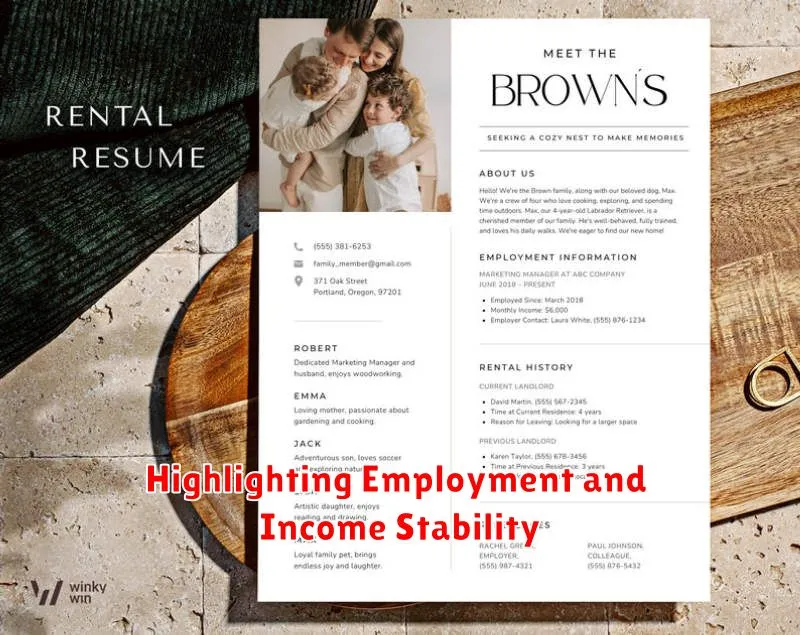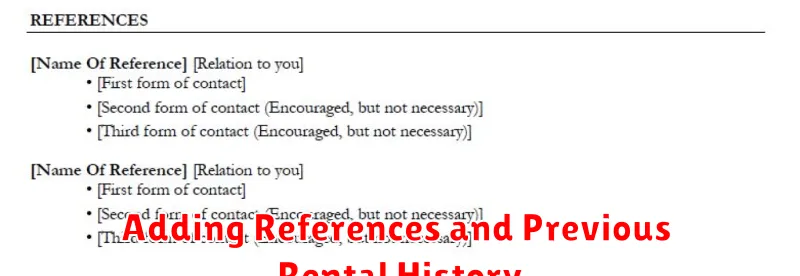Finding the perfect rental property can feel like a competitive sport, especially in a tight market. A well-crafted rental resume can be your secret weapon, showcasing your qualifications and making you stand out from other applicants. Learn how to write a rental resume that gets you approved, covering essential elements like credit score, rental history, income verification, and references. Maximize your chances of securing your dream rental by presenting a compelling and professional application.
This guide provides a comprehensive overview of creating a winning rental resume. We’ll cover what information to include, how to format it effectively, and tips for making your application shine. From highlighting your strong rental history and stable income to providing solid references and addressing any potential concerns, we’ll equip you with the tools to impress landlords and secure your next lease. Get ready to transform your rental application from ordinary to extraordinary and increase your chances of getting approved.
Why a Rental Resume Can Make a Difference
In a competitive rental market, a well-crafted rental resume can significantly improve your chances of securing your desired property. It provides landlords with a concise and organized overview of your qualifications, saving them time and making it easier for them to assess your suitability as a tenant. Think of it as your chance to make a strong first impression and stand out from other applicants.
A rental resume goes beyond a basic application by showcasing your rental history, employment stability, and financial responsibility. It allows you to highlight positive attributes that might not be apparent in a standard application form. You can include references from previous landlords, demonstrating your reliability and responsible tenancy. Additionally, providing information about your income and credit score upfront builds trust and transparency with potential landlords.
By presenting yourself professionally and proactively with a rental resume, you demonstrate your seriousness as a prospective tenant. This can give you a competitive edge, especially when multiple applicants are vying for the same property. Taking the time to create a comprehensive rental resume shows landlords that you’re organized, responsible, and respectful of their time, ultimately increasing your chances of getting approved.
What to Include in Your Rental Resume
A rental resume is a tool to help you stand out from other applicants and secure your desired rental property. It provides landlords with a comprehensive overview of your qualifications and demonstrates your responsibility as a potential tenant. Include key information such as your contact information (phone number, email address, current address), employment details (employer, position, length of employment, income), and previous rental history (landlord contact information, rental duration). Providing this information upfront streamlines the application process for both you and the landlord.
In addition to the basics, consider including references. Personal references can speak to your character and reliability, while professional references can vouch for your professionalism. Offering references proactively demonstrates your willingness to be thoroughly vetted. You can also include information about your pets, if applicable, such as breed, age, and vaccination records. Being upfront about pets can save time and prevent potential misunderstandings later. Finally, consider a brief personal statement highlighting your reasons for moving and what you’re looking for in a rental. This allows you to present yourself positively and express your commitment to being a good tenant.
By presenting a well-organized and informative rental resume, you present yourself as a serious and desirable tenant. This proactive approach can significantly increase your chances of securing your ideal rental property in a competitive market. Remember to keep it concise and professional, focusing on the information most relevant to landlords.
Highlighting Employment and Income Stability

Employment and income stability are crucial factors in assessing financial health. Stable employment, often characterized by consistent work with the same employer for an extended period, demonstrates reliability and reduces the risk of income disruption. This stability provides a predictable income stream, which is essential for budgeting, financial planning, and accessing credit. Lenders and creditors view stable employment as a positive indicator of an individual’s ability to meet their financial obligations.
Income stability refers to the consistency and predictability of an individual’s income over time. This means that the amount of income received remains relatively constant, allowing for reliable financial planning. While stable employment often contributes to income stability, other factors like investments, rental income, or other consistent sources can also play a role. Demonstrating income stability reassures lenders and creditors of a borrower’s capacity to repay debts and manage finances effectively.
Indicators of strong employment and income stability often include a lengthy tenure with a current employer, consistent income growth, and a positive employment history. These factors demonstrate a reduced risk of default and contribute to a stronger financial profile.
Adding References and Previous Rental History

Providing references and previous rental history is a crucial step in the application process. This information helps landlords verify your reliability as a tenant, demonstrating your payment history and adherence to lease terms. Strong references can significantly improve your chances of securing a rental property. Be prepared to provide contact information for previous landlords, including their names, phone numbers, and email addresses. You may also want to include personal references who can speak to your character and responsibility.
When compiling your rental history, ensure accuracy and completeness. List your previous addresses, the dates of your tenancy, and the landlord’s contact information for each property. If you have any gaps in your rental history, be prepared to explain them clearly and honestly to potential landlords. For example, you may have lived with family or owned a home during those periods. Providing context for any gaps will help build trust and transparency with the landlord.
Be proactive in contacting your references to let them know a potential landlord might be reaching out. This allows them to be prepared and provide a positive and informed response. By organizing and readily providing this information, you demonstrate your seriousness as a prospective tenant and increase your chances of a successful application.
Using a Clean and Professional Format
Professional formatting enhances readability and credibility. It ensures that your documents are clear, concise, and easy to understand. This includes using consistent fonts, appropriate spacing, and logical organization. A clean, professional format makes a strong positive impression, whether it’s a business report, academic paper, or even a simple email. It reflects attention to detail and respect for the reader’s time.
Key elements of professional formatting include clear headings and subheadings, consistent use of bold and italic text for emphasis, and numbered or bulleted lists for clarity. Maintaining proper margins and consistent line spacing further contributes to a polished look. Consider your audience and the purpose of the document when choosing a specific format. A resume, for instance, will have different formatting requirements than a research paper.
Ultimately, the goal is to present information in a way that is both visually appealing and easy to digest. By adhering to professional formatting guidelines, you can ensure that your message is communicated effectively and efficiently. This leads to improved comprehension and a more positive overall experience for the reader.
Tips for Standing Out from Other Applicants
In today’s competitive job market, simply meeting the minimum requirements isn’t enough. To truly stand out, you need to demonstrate your unique value and passion. Research the company and the specific role thoroughly. Tailor your resume and cover letter to highlight relevant skills and experiences. Quantify your accomplishments whenever possible, using numbers and data to showcase your impact in previous roles. Go beyond simply listing your responsibilities; explain how you exceeded expectations and contributed to the organization’s success.
Networking is crucial. Attend industry events, connect with professionals on LinkedIn, and reach out to people working at your target company for informational interviews. These conversations can provide valuable insights into the company culture and the specific role, while also demonstrating your proactive approach. Prepare thoughtful questions and follow up with a thank-you note to leave a lasting impression. Finally, practice your interviewing skills. Be prepared to discuss your strengths, weaknesses, and career aspirations with confidence and clarity.
Consider adding a portfolio or personal website to showcase your work and further differentiate yourself. Highlight projects, publications, or other accomplishments that demonstrate your skills and expertise. This extra effort can signal your dedication and enthusiasm to potential employers. Remember, the key is to present yourself as a well-rounded candidate who brings not only the necessary skills but also a strong work ethic and a genuine interest in the opportunity.
Sample Rental Resume Template
A rental resume is a document used to showcase your qualifications as a prospective tenant to a landlord. It helps you stand out from other applicants by providing a comprehensive overview of your background, financial stability, and rental history. A well-crafted resume can significantly increase your chances of securing your desired rental property.
Key information to include is your contact information (phone number, email address), current employment details (employer, position, income), rental history (previous addresses, landlord contact information), personal references, and any additional information that might strengthen your application, such as credit score or pet information. Be sure to present the information in a clear, concise, and professional manner.
Remember to tailor your rental resume to each specific property you apply for, highlighting relevant aspects of your background and emphasizing your suitability as a tenant. Proofread carefully for any errors before submitting. A polished and professional rental resume demonstrates your seriousness and responsibility as a potential renter.

